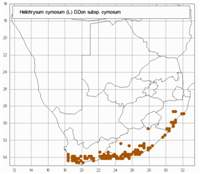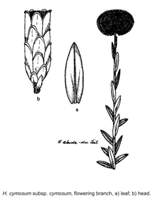Common names:
Yellow-tipped straw-flower, impepho (Z).
Origin of name:
ymosus /-a/-um = flat-topped flower clusters; with flowers in clusters opening from the centre outwards
Diagnostic characters:
Short flat leaves hanging down, prominently veinedRather large branched inflorescencesYellow bracts
Description:
A well-branched spreading subshrub up to 1 m tall, branches long, often decumbent at the base then erect, thinly greyish-white woolly, densely leafy, becoming pedunculoid upwards. Leaves very variable, mostly 8-15 (-45) x 2-4 (-15) mm, becoming smaller and more distant upwards, elliptic-oblong or linear-oblong, apex acute, sometimes acuminate, mucronate, slightly narrowed to a half-clasping, subdecurrent base, margins flat or subrevolute, upper surface clothed in thin silvery grey sericeous indumentum that will strip like a skin (and sometimes does), rarely woolly-felted, lower surface closely white-woolly. Heads heterogamous or sometimes homogamous, cylindric, mostly c. 3 x 1 mm, sometimes up to 4.5 x 3 mm, many in compact cymes corymbose-paniculately arranged at the branch tips. Involucral bracts in c. 4 series, graded, closely imbricate, inner about equaling flowers, not radiating, translucent, glossy, bright canary-yellow, tips generally smooth. Receptacle with fimbrils exceeding the ovaries. Flowers 6-12 (-20), 0-4 female, 3-12 (-20) homogamous, yellow. Achenes 0.75 mm, broadly cylindric, glabrous. Pappus bristles many, scabrid, bases cohering strongly by patent cilia.
Flowers between September and April.
Distribution:
Grows in big straggling clumps, often in moist places, such as hollows between the coastal dunes, in shrub communities, both in the Cape scrub and on forest margins. H. cymosum subsp. cymosum ranges from the Western Cape, including the Peninsula, eastwards along the coast and the coastal mountain ranges, then north-east both along the coast and inland to Albany district, Katberg and the Amatola Mountains, and as far as Lake St Lucia in Natal. Occurs up to c. 1 500 m above sea level in the Cape mountains, but not above 600 m in Natal.
Fynbos, Thicket, Grassland and Savanna Biomes.
Notes:
H. cymosum subsp. cymosum shows considerable variation in head size. Heads are commonly c. 3 x 1 mm but larger-headed plants occur erratically from the Cape Peninsula to the Umzimkulu River on KwaZulu-Natal's southern border, and, from the herbarium records, appear often to grow with the typical small-headed plant. This increase in head size is due, not to an increase in flower number, but to an increase in flower size: corolla length ranges from 2�3.5 mm, and there is a corresponding increase in corolla width.
H. cymosum can be recognized by its cylindric heads with canary-yellow bracts, and leaf shape and indumentum; the leaves are generally elliptic-oblong to linear-oblong with acute tips, the upper surface covered with paper-like indumentum. Only rarely are the leaves (apart from the uppermost ones) acuminate or the upper leaf surface cobwebby or thinly woolly.
H. melanacme is sometimes confused with H. cymosum. The leaves of H. melanacme are lanceolate, acuminate, and usually thinly woolly above, therefore leaf shape and indumentum will distinguish most specimens of H. cymosum from H. melanacme. Furthermore, the involucral bracts of H. melanacme are tawny or sometimes straw-coloured, the tips crisped, not smooth or nearly so as they usually are in H. cymosum. Confusion can also arise with H. tenuiculum; see under that species.
Two subspecies are recognized:
1a Heads with 6�20 flowers, fimbrils more than twice as long as ovary, pappus copious
(a) subsp. cymosum
1b Heads with 4�7 flowers, fimbrils about as long as ovary, pappus wanting
(b) subsp. calvum
Taxonomy:
Literature:
Helichrysum cymosum (L.) D. Don in Sweet, Hort. Brit. 223 (1826), in Loudon, Hort. Brit. 342 (1830); Less., Syn. Comp. 302 (1832); Harv. in F.C. 3: 245 (1865); Moeser in Bot. Jb. 44: 256 (1910); Batten & Bokelmann, Wild Flow. E. Cape Prov. 152, plate 122, 2 (1966); Hilliard, Compositae in Natal 168 (1977).
Type:
Cape of Good Hope, Gnaphalium sheet no. 7 in herbarium Hort. Cliff. (BM)
Synonym(s):
Gnaphalium cymosum L., Sp. Pl. 855 (1753). Lepiscline cymosum (L.) Cass., Dict. Sci. nat. 26: 49 (1823).
G. spadiceum Lam., Encycl. 2: 753 (1788). Type: Cape of Good Hope (P-LAM).
G. cernuum Thunb., Prodr. 150 (1800), Fl. Cap. 654 (1823). Type: Table Mountain, Thunberg (sheet 19113, UPS).
Helichrysum subdecurrens DC., Prodr. 6: 202 (1838). Gnaphalium subdecurrens (DC.) Sch. Bip. in Bot. Ztg 3: 172 (1845), non DC. (1834). Type: Cape, near George, on Cradock Berg, 12 ix 1814, Burchell 5970 (G-DC, holo.; K, iso.).
H. parviflorum var. aureum DC., Prodr. 6: 203 (1838). H. cymosum var. pauciflorum Harv. in F.C. 3: 246 (1865). Lectotype: Cape, Uitenhage, Burchell 4226 (G-DC misquoted by DC. as 4216).
H. cymosum var. minus [Sond. ex] Harv. in F.C. 3: 246 (1865). Type: Cape, Zeyher 883 (S, holo.; E; K, iso.).
Vouchers:
Acocks 11109 and 22975 (PRE); Esterhuysen 20764 (BOL; PRE); Flanagan 417 (PRE); Hilliard & Burtt 6061 (E; K; MO; NU; S); Wright 976 (E; K; NH; NU; M).


